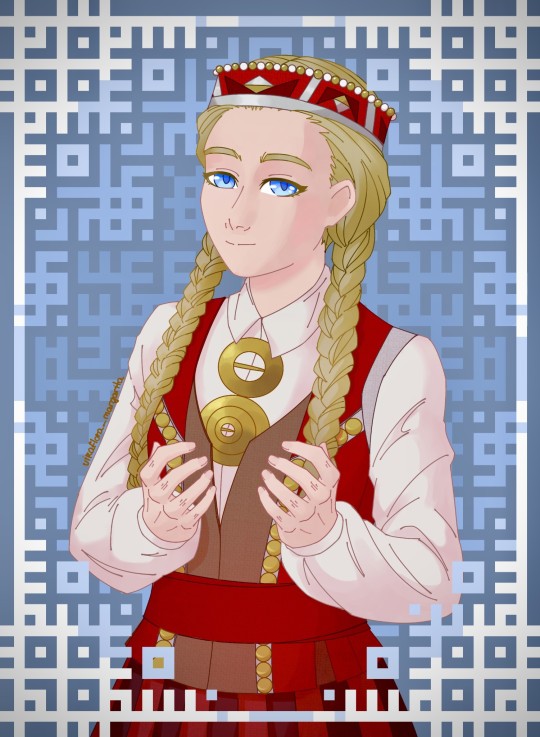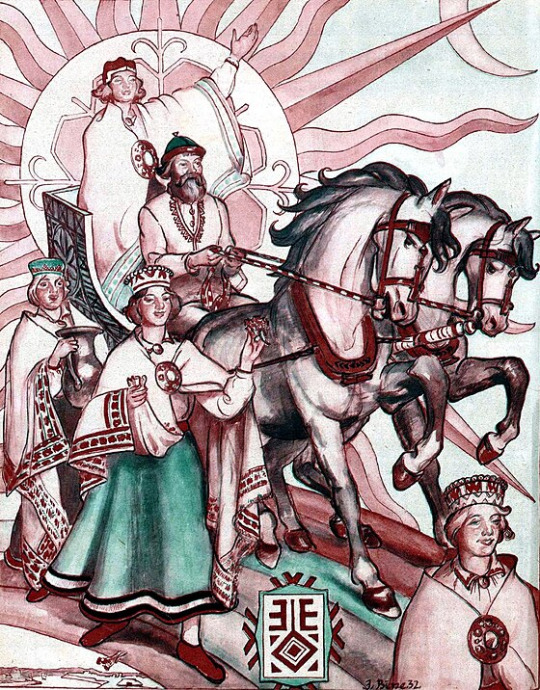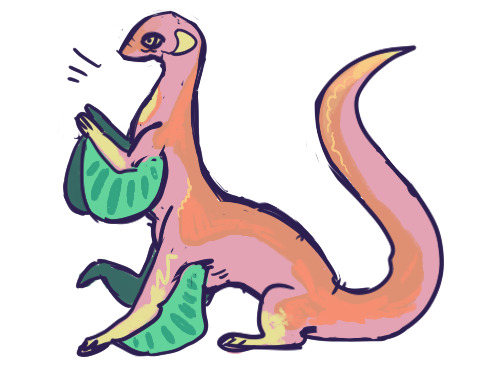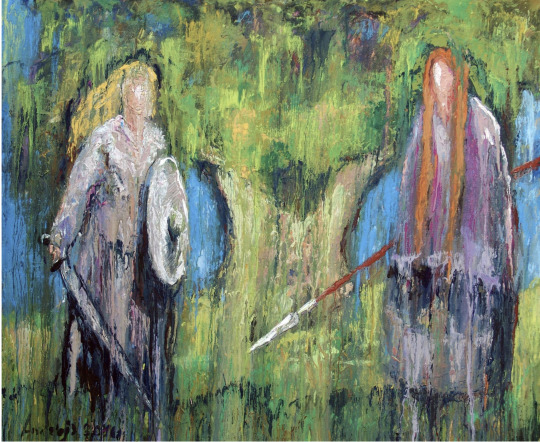#latvian mythology
Explore tagged Tumblr posts
Text
Mythology Olympics tournament round 1
Propaganda!


Lietuvēns or lietonis is a mythological creature in Latvian folklore. According to Latvian folk epics and omens, lietuvēns is the soul of a murdered (strangled, drowned or hanged) person cursed to live in this world as long as it has been meant to live. By some beliefs, it is the soul of an unbaptized child. It attacks both people and domestic animals. Sleep paralysis is thought to be torture or strangling by a lietuvēns. When under attack, one must move the toe of the left foot to get rid of the attacker. It is also said that lietuvēns is able to penetrate into houses, even through keyholes and, aside from nightmares, can strangle the victim.
Propaganda from the submitter:
Apparently ancient latvians had sleep paralysis too and this is the guy that causes it. Folk wisdom says to wiggle your toe to make him go away, but why would you want to? Hes just a little guy! Wikipedia describes him looking as "a labored wretched child" - just like me fr. Vote lietuvēns guys
Aulë was a Vala and one of the Aratar, also known as the Smith and Smith of the Valar, concerned with rock, metal, nature of substances and works of craft. Aulë governed the substances of the Ambar and he delighted in all works and crafts all of which he was master, from small works of skin to the forging of all lands and mountains and basins of the sea. He made the rocks, the gems and all minerals. He enjoyed devising and making new things, and being praised. In these thoughts and powers he was like Melkor, as Ilúvatar gave him scarce less skill and knowledge. Aulë had always been faithful to Eru and submitted all his creations to His will. He was never jealous of others' creations, but sought and gave counsel. He enjoyed the things he has created and in act of making itself and passed ever to some new work, without hoarding or possessing. For this, there was much strife between him and Melkor who envied him; Melkor always marred his work and Aulë always sought to repair them.
#Lietuvēns#Lietuvens#latvian mythology#Aulë#aule#tolkien#jrr tolkien#the silmarillion#the silm fandom#lotr#lord of the rings#tournament poll#polls#wikipedia#mythology#mythology tournament
35 notes
·
View notes
Text
"There are also reports of werewolves (vilkači, vilkati) – humans who could turn into wolves. The turning was usually accidental as it happened when someone stood between two pines which had grown together at a certain time. This time varied depending on the region. There are conflicting reports on what forces they serve, though they usually serve no one and are just beasts."
7 notes
·
View notes
Text

Dēkla. The goddess of fate, Laima.
Laima is arguably the most prominent and well-known latvian pagan deity. She decides a person's fate from the moment they are born. In some folk songs she is said to cry over her duty, a trait no other god of fate has been recorded to share with her.
Dēkla is an another name Laima went by in the region of Courland. At first, it was thought that she was one of the three sisters of fate (a common motif in many indoeuropian religions), but no substantial evidence was found in favour of this theory in more recent years.
I decided to call her Dēkla, because her clothes were inspired by Curonian folk costume.
If you want to learn more about Laima and/or Dēkla, I warmly recommend reading this latvian mythology/folklore archive (in latvian)
23 notes
·
View notes
Text

Janis Rozentāls (Latvian 1866-1916), Nāve (Death), 1897. Oil on canvas, 69 x 98 cm. | 27.1 in x 38.5 in. (Source: Latvijas Nacionālais mākslas muzejs, Riga, Latvija)
#Janis Rozentāls#art#late 19th century art#realism#art nouveau#figurative art#symbolic painting#Latvian art#Latvian artist#Latvian mythology#Latvian folklore#Mother of Death#Nāve#symbolism#The Askew#theaskew
9 notes
·
View notes
Text
MĀRA // LATVIAN GODDESS OF ALL FEMININE DUTIES, ECONOMIC ACTIVITIES, MONEY & MARKETS
“She is the highest-ranking goddess in Latvian mythology, the ancient Dawn-goddess, previously called Austra, and, not at all, although often stated, the same as Zemes māte (Mother Earth, pace). She is the patroness of all feminine duties (children, cattle), patroness of all the economic activities ("God made the table, Māra made the bread"), even money and markets. Being the alternate side of Dievs, she takes a person's body after their death while Dievs is taking the soul.”
0 notes
Text
The Latvian God of Spring
A father deity Illustration by Jēkabs Bīne (1895 – 1955) To me he looks a bit like Atilla the Hun. The back to back E is one of Ūsiņš symbols. He and his horses are the bingers of the sun .You would expect that the day honoring the god of spring would be the equinox on March 20th. However, Ūsiņa diena (Ūsiņš day) is celebrated on April 23. I don’t know the reason for this discrepancy. So, I’m…

View On WordPress
0 notes
Photo

Jana Brike, for her Solo exhibition "Children of the Sun" opening on November 23 at @beinartgallery, Australia. Jana Brike was born in year 1980 in Riga, Latvia.
#jana brike#children of the sun#solo exhibition#2024#oil painting#painting#art#latvian artist#mythology#three graces#myth#sisterhood#flowers#protection#crown#connection#blessing#women#portrait#sun#children#surrealism#figurative art#contemporary art
126 notes
·
View notes
Text
youtube
"I want more songs about werewolves!" don't worry, babe, Skyforger has got you covered.
The story of Thiess of Kaltenbrun (yes, that Thiess; the Livonian Thiess. The Werewolf of Zaube, Livonia).
His full story is under the video, and there's English subtitles, too.
(Kaltenbrun was Kniediņi, btw; Jürgensburg was Zaube)
#Uupiic listens to music#FUCK YES THE LADS ARE BACK#Excited to find out what else they have in the new album#''Teikas'' as a name alone and now THIS? that sounds like one hell of a dive into the Latvian mythology and history
4 notes
·
View notes
Text
An interview/podcast with the front man & guitarist of Skyforger - Pēteris Kvetkovskis. The folk, pagan and black metal band originates from Northern Europe, specifically Latvia where they have been playing since 1995. In these two-part podcast episodes you can learn more about the importance of pagan music for Skyforger; their influence in music and the nature of the environment the band originates from.
''Politicians have shown interest in our music. We have been asked to participate in concerts during the voting period of the political parties, when they tried to gain votes. But we have not participated in such things. That's not our thing. We don't want to be used as clowns or be used as idiots, for them to get some kind of benefit from our music. The Latvian Government has supported us. ''
''Our motto would be to do what you like. Live as you want, as long as it you don’t disturb other people. I have often wondered to myself and thought that young people never listen to the old ones. The youth lives in their own world. If I can give any advice, for those who want to play- Find your own path. Try as best as possible to not copy your idols or popular music which is listened to by thousands of people. I know that it is pleasant, to play like your idols, because you feel like your equal to them. But another Metallica is not needed, make your own music.'' - Pēteris Kvetkovskis.
© BALTIC PAGROCK
#skyforger#latvia#folk#latvian#metal#folk metal#baltic#music#new#interview#podcast#pegan#mythology#history#music reccomendations#music review#author#substack#metal heroes#estonia#lithuania#finland#sweden
3 notes
·
View notes
Text
ah, my greatest enemy. my own autism
#help help help my religious studies brain has activated but it is focusing on ANYTHING but my actual project#i need to be compiling a research archive about indigenous localized bhutanese religion#but i can only focus on gnostic christianity around the second and third centuries????? HELP#and neil gaiman's norse mythology and how I can apply his strategies to my own future projects with the latvian pantheon#these are NOT the things i shoulf be focusing on#someone kick me#rambles
4 notes
·
View notes
Text

if it looks weird, its a dragon
#medieval inspired#dragon art#dragon oc#original creature#original species#mythologyart#baltic mythology#sorta kinda based on latvian mythology
3 notes
·
View notes
Text
Flow (Straume) - Movie Review
TL;DR – A stunning work of animation that conveys so much without saying a word. You are brought into this story in the opening moments, and it captivates you until the final frame. ⭐⭐⭐⭐⭐ Rating: 5 out of 5. Post-Credit Scene – There is an end-credit scene.Disclosure – I paid to watch this film Flow Review – There was one film that I wanted to catch last year, but no matter how much I…

View On WordPress
#Animated#Animation#Baltic Cinema#Belgian Cinema#Cat#Family#Flow#French Cinema#Journey to the West#Latvian Cinema#Mythology#Straume#Water
0 notes
Note
While I was going to eat lunch, Devil!Stone told me that his name is Lucifer II. Which makes sense since he's a demon, so he wouldn't have a regular name like Vikram. I do find it a little funny that Lucifer named Devil!Stone after himself when Bharat traded baby Devil!Stone for refuge in Hell, but I'm not entirely surprised.
He and Grim Reaper!Stone can bond over having the same name as their father/father figure.
lucifer 2... its kinda cute ngl. but also. seriously??? not even diablo?? or whatever other names for the devil there are in other languages???
#well. maybe dont let it be in a diff lamguage#jehehehe imagining devil stone being called the latvian version of “devil”#which is “velns”#and#in mythology; that guy is just some poor evil spirit constantly having the worst day of his life#they made a movie about that like. idk 50 years ago. mb less#about how mortals constantly kept beating his ass#the theme song is such a banger tho#sorry im rambling#using this to let out pent up energy instead of ranting on main for the 48463848468338th time#response#the-whispers-of-death
0 notes
Text

Andrejs Bovtovičs (Latvian b. 1959), Laima and Mara, acrylic on canvas.
#art#artwork#modern art#modern artwork#contemporary art#contemporary artwork#21st century modern art#21st century contemporary art#Latvian art#modern Latvian art#modern Latvian artwork#contemporary Latvian art#contemporary Latvian artwork#Latvian artist#Latvian painter#Andrejs Bovtovičs#acrylic on canvas#Latvian mythology#Latvian folklore#Laima#Latvian goddess#Māra
5 notes
·
View notes
Text

For Folklore Sunday, we’re going back to Latvia for the continuing saga of Lacplesis the Bearslayer! What lurks beneath the catacombs of an ancient castle? Even older libraries and monsters of course! Then in Gods and Monsters, a white deer will turn the tables.
#mythology#podcast#folklore#mythology podcast#episode#podcasters of tumblr#podcastersunite#monsters#fairy tales#gods#latvia#latvian#folklore Sunday
0 notes
Text

Out of context Lāčplēsis
1 note
·
View note